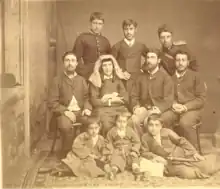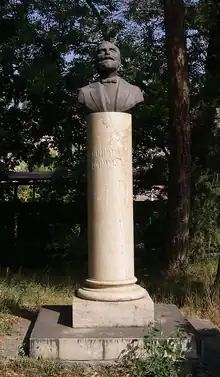Nikoghayos Tigranian | |
|---|---|
 | |
| Background information | |
| Birth name | Nikoghayos Tigranian |
| Born | 31 August 1856 Alexandropol |
| Died | 17 February 1951 Yerevan |
| Genres | Classical music |
| Occupation(s) | Composer, pianist, musicologist |
Nikoghayos Tigranian (Armenian: Նիկողայոս Թադևոսի Տիգրանյան, 31 August 1856, Alexandropol – 17 February 1951, Yerevan) was an Armenian composer, pianist, musicologist, and sociocultural activist. He introduced the Braille System to Armenia.[1]
Biography
Nikoghayos Tigranian was born in Alexandropol in the Russian Empire (present-day Gyumri, Armenia) to a prominent family. His younger brother Sirakan Tigranian was the foreign minister of the First Republic of Armenia. Hovsep and Ghazar Tigranian, also his brothers, were trustees of Nersisian School.
Nikoghayos lost his sight at the age of 9 as a result of smallpox.[2] His family sent him to Vienna in 1873 to study at the Imperial Royal Institute for the Education of the Blind[3] (1873–1880). He also took piano lessons from Professor Schenner of the Vienna Conservatory (now named University of Music and Performing Arts).
He returned to his homeland in 1880. He gave piano recitals and delivered lectures in Western Europe, Russia and Transcaucasia, and published several articles on Oriental music. In 1893, Tigranian studied composition at the St. Petersburg Conservatory with Rimsky-Korsakov and N.F. Solovyov.
Music

He collected folk music, particularly mughams, which he used in original works and in various arrangements. He was awarded a bronze medal at the 1900 Paris International Festival as a “pioneer in collecting and featuring Oriental melodies”. It was through his efforts that melodies sung at the turn of the previous century in Transcaucasia by Armenian, Persian and Kurdish peoples were preserved. A number of composers, including Alexander Spendiaryan, Aram Khachaturian, Mikhail Ippolitov-Ivanov, Reinhold Moritzevich Glière, Armen Tigranian, and Sargis Barkhudaryan, have utilized these melodies in their own compositions. Tigranian was the first composer to translate such music into orchestral terms.[4]
In his compositions, Tigranian's motto was to always stay faithful to the spirit of the folk music, to communicate the timbre of folk instruments, and to retain the plasticity of folk dances. His approach became an example to other composers who expanded further Tigranian's ideas and tools.
In 1921, Nikoghayos Tigranian implemented the Braille System for the first time in Armenia at the Gyumri school he founded.
He moved to Yerevan in 1934 where he died in 1951. A collection of his articles, memoires and letters was published in 1981. A street in Yerevan and the Art School of Gyumri are named after him.

Awards
- People's Artist of the Armenian SSR (1933)
- Hero of Socialist Labour (1936)
- Order of the Red Banner of Labour (1939)
References
- ↑ Կարինե Խուդաբաշյան. Հայկական սովետական համայնագիտարան (Soviet Armenian Encyclopedia). Vol. 11, p. 702. Yerevan, 1985.
- ↑ "Նիկողայոս Տիգրանյան" [Nikoghayos Tigranian]. musicofarmenia.com. Retrieved 24 September 2021.
- ↑ "Perkins School for the Blind | Imperial Royal Institute for the Education of the Blind, Vienna". www.digitalcommonwealth.org/. Retrieved 23 September 2021.
- ↑ Ellen Koskoff, ed. (2013). The Concise Garland Encyclopedia of World Music Volume 2. Routledge. p. 848. ISBN 9781136096020.
Bibliography
- Ruzanna Mazmanyan. Nikoghayos Tigranyan: Ocherk Zhizni i Tvorchestva [Essay on Life and Creativity]. Yerevan: Sovetakan Grokh, 1978.
- Nikoghayos Tigranyan. Hodvatsner, husher, namakner, 1981
- NIKOLAY FADDEEVICH TIGRANOV Oriental Music, Leningrad 1927. Lonigradskiy Gublit e 36130, 31/2 nel. A. - Circulation 1000 The State Academic Printing House. VO, line 9. Book in Russian.
External links
 Media related to Nikoghayos Tigranian at Wikimedia Commons
Media related to Nikoghayos Tigranian at Wikimedia Commons- Biography
- Biography
- A letter from Komitas